Toshio Nozaka: Research Areas
Current Research Interests: Evolution and dynamics of oceanic and continental lithosphere
- Petrology of water-rock interaction and tectonics of oceanic lithosphere
- Metamorphic and deformation history of ophiolite peridotites
- Prograde metamorphism of serpentinites
- Upper mantle and lower crustal xenoliths and evolution of continental lithosphere
- Regional metamorphism and tectonics of eastern Eurasia
Current/Recent Research Projects
- Oceanic lower crust alteration, Hess Deep Rift (IODP)
- Eastern Desert ophiolites, Egypt
- Oceanic core complex formation, Atlantis Massif (IODP)
- Mohole to Mantle (IODP)
- Metamorphic history of peridotites in high-P/T metamorphic terrains, Japan
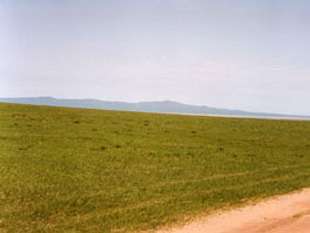
A distant view of the Hegenshan ophiolite, Inner Mongolia
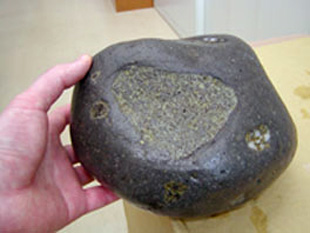
Directions to the Campus
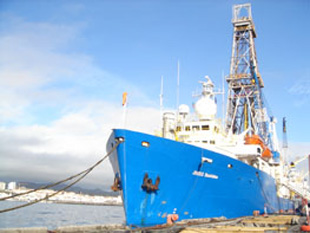
JOIDES Resolution at Azores, IODP Expedition 305
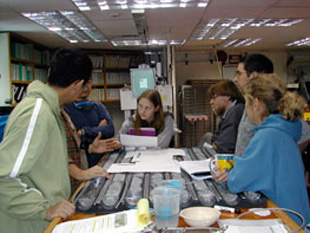
Rocks from Atlantis Massif and shipmates at IODP Expedition 305
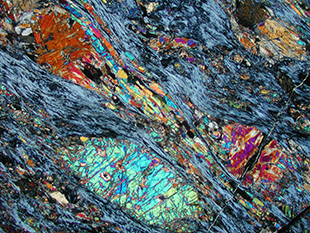
Photomicrograph of a serpentinite mylonite from the Happo ultramafic complex (crossed polars, FOV = 5.7 mm wide)
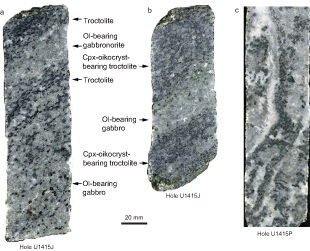
Gabbroic rocks of the Pacific lower crust recovered from the Hess Deep Rift, IODP Expedition 345 (Gillis et al., 2014)
Outline of Research Results
- Finding of metasomatic veining, and immediate cooling and deformation of peridotites from the Oeyama forearc ophiolite. This finding suggests that the infiltration of aqueous fluids from subducting slab to mantle wedge triggered the softening and exhumation of forearc peridotite bodies (Nozaka, 2014).
- Finding of vein-related zoned alteration halos in olivine gabbros from IODP Hole U1309D at Atlantis Massif, Mid-Atlantic Ridge. Petrological evidence suggests that the zoned halos were caused by prolonged or sequential infiltration of hydrothermal fluids under amphibolite-facies conditions. The amphibolite-facies alteration between gabbros and peridotites could be a trigger of the exhumation of oceanic core complexes at slow-spreading ridges (Nozaka and Fryer, 2011).
- Finding of oxidized vermiculite and talc-saponite mixed layer in gabbroic rocks from Atlantis Massif. This is the first report of these clay minerals from oceanic gabbros. The formation of the clay minerals suggests relatively rapid exhumation of the oceanic core complex from a lower-crustal depth to an oxidizing sub-seafloor level at slow-spreading ridges (Nozaka et al., 2008).
- Finding of the differences in the degree of homogenization between anthophyllite-bearing and anthophyllite-lacking ultramafic contact aureoles in SW Japan. The lack of anthophyllite was probably caused by the sluggish nucleation of this mineral and insufficient heat-retention duration at the time of metamorphism (Nozaka, 2011).
- Finding of a genetic relationship between the parting of “cleavable” olivine and serpentinite mylonites. Petrological evidence suggests that the parting was caused by dislocation arrangement by recovery processes after plastic deformation of hydrous peridotites and brought into prominence during syntectonic serpentinization. The preferred orientation of the parting planes suggests that cleavable olivine is a potential indicator of regional tectonics of the upper mantle at supra-subduction zones (Nozaka and Ito, 2011).
- Finding of a new locality of serpentinite mylonite: the Happo ultramafic complex, central Japan. This unique type of rock provides an opportunity for studying the exhumation tectonics of upper mantle materials at convergent plate boundaries. Petrological studies revealed that two stages of mylonitization took place under different temperature conditions: earlier formation of hydrous peridotite mylonites at 700-800ºC and later formation of serpentinite mylonites at 400-600ºC, and that during the later stage, antigorite + diopside syntectonicaly formed at the expense of olivine + tremolite. It is the “high-temperature serpentinization” that forms this type of serpentinite, which is clearly different from prograde antigorite schists and lizardite-dominant serpentinites, which frequently occur in orogenic belts and the seafloor, respectively.
- Finding of a systematic chemical variation, i.e., Na/Si ratio of tremolite in metaperidotites. The compositional characteristics of tremolite will be a good indicator for discrimination between prograde and retrograde metamorphic assemblages, and provide a constraint on tectonic histories of metaperidotites (Nozaka, 2005).
- Finding of compositionally heterogeneous olivine formed by prograde metamorphic reactions involving serpentine, magnetite and awaruite in mete-serpentinites. It contributes to the basic understanding of low temperature metamorphic processes in ultrabasic systems (Nozaka, 2003).
- Finding of serpentinite-hosted blueschist blocks that have constant, low Fe3+/Fe2+ ratio, which suggests a highly reducing condition and external control of oxygen fugacity during high-P/T metamorphism, and buffering of oxygen fugacity by serpentinization-related reducing fluids. This is an important case showing apparent mobility of oxygen (i.e., hydrogen mobility) during metamorphism (Nozaka, 1999).
- Finding of pyroxenite, gabbro and anorthosite xenoliths that contain corundum, kyanite and pseudomorphs (olivine + plagioclase + spinel aggregates) after garnet in Cenozoic basalts from SW Japan. Their mineralogy and texture suggest crustal evolution by magma underplating under pre-existing Moho and assimilation of basaltic magma by peraluminous pre-existing lower crustal rocks (Nozaka, 1997).
- Finding of ophiolitic complexes that show geochemical and mineralogical evidence for mid-oceanic ridge origin and high- or middle-P/T metamorphism around 110-130 Ma at the Hegenshan area in Inner Mongolia, China. This suggests the collision of the Siberia and North China cratons and suturing an intervening ocean in middle Mesozoic time (Nozaka and Liu, 2002, 2003).
- Contributions to understanding regional geology and tectonics of SW Japan and eastern Asia (Nozaka et al., 2002, etc.).
Publication List
- Nozaka, T. (2014) Comment on "Dehydration breakdown of antigorite and the formation of B-type olivine CPO" by Nagaya et al. (2014) Earth and Planetary Science Letters, in press.
- Nozaka, T. (2014) Metasomatic hydration of the Oeyama forearc peridotites: Tectonic implications. Lithos, 184-187, 346-360.
- Gillis, K.M., Snow, J.E., Klaus, A., Abe, N., Adrião, A.B., Akizawa, N., Ceuleneer, G., Cheadle, M.J., Faak1, K., Falloon, T.J., Friedman, S.A., Godard, M., Guerin, G., Harigane, Y., Horst, A.J., Hoshide, T., Ildefonse, B., Jean, M.M., John, B.E., Koepke, J., Machi, M., Maeda, J., Marks, N.E., McCaig, A.M., Meyer, R., Morris, A., Nozaka, T., Python, M., Saha, A. and Wintsch, R.P. (2014) Primitive layered gabbros from fast-spreading lower oceanic crust. Nature, 505, 204-207.
- Gillis, K.M. Snow, J.E. Klaus, A. and the Expedition 345 Scientists (2014) Proceedings of the Integrated Ocean Drilling Program, Expedition 345, Hess Deep Plutonic Crust: Exploring the Plutonic Crust at a Fast-Spreading Ridge: New Drilling at Hess Deep. Integrated Ocean Drilling Program, College Station, USA, doi:10.2204/iodp.proc.345.
- Expedition 345 Scientists (2013) Hess Deep plutonic crust: exploring the plutonic crust at a fast-spreading ridge: new drilling at Hess Deep. IODP Preliminary Report. Integrated Ocean Drilling Program Management International, Inc., College Station, USA.
- Nozaka, T. (2012) Petrological constraints on hydrogen production during serpentinization: a review. Japanese Magazine of Mineralogical and Petrological Sciences, 41, 174-184 (in Japanese with English abstract).
- Blackman, D.K., Ildefonse, B., John, B.E., Ohara, Y., Miller, D.J. and IODP 304-305 Science Party. (2011) Drilling Constraints on Lithospheric Accretion and Evolution at Atlantis Massif, Mid-Atlantic Ridge 30ºN. Journal of Geophysical Research, 116, B07103, doi: 10.1029/2010JB007931.
- Nozaka, T. (2011) Constraints on anthophyllite formation in thermally metamorphosed peridotites from southwestern Japan. Journal of Metamorphic Geology, 29, 385-398.
- Nozaka, T. and Fryer, P. (2011) Alteration of the oceanic lower crust at a slow-spreading axis: insight from vein-related zoned halos in olivine gabbro from Atlantis Massif, Mid-Atlantic Ridge. Journal of Petrology, 52, 643-664.
- Nozaka, T. and Ito, Y. (2011) Cleavable olivine in serpentinite mylonites from the Oeyama ophiolite. Journal of Mineralogical and Petrological Sciences, 106, 36-50.
- Kakiya, S., Kudo, K., Nishikubo, Y., Oku, K., Nishibori, E., Sawa, H., Yamamoto, T., Nozaka, T. and Nohara, M. (2011) Superconductivity at 38K in the iron-based compound with platinum-arsenide layers Ca10(Pt4As8)(Fe2-xPtxAs2)5. Journal of the Physical Society of Japan, 80, 093704, doi: 10.1143/JPSJ.80.093704.
- Nozaka, T. (2010) A note on compositional variation of olivine and pyroxene in thermally metamorphosed ultramafic complexes from SW Japan. Okayama University Earth Science Reports, 17, 1-5.
- Nozaka, T., Fryer, P. and Andreani, M. (2008) Formation of clay minerals and exhumation of lower-crustal rocks at Atlantis Massif, Mid-Atlantic Ridge. Geochemistry Geophysics Geosystems, 9, Q11005, doi:10.1029/2008GC002207.
- Michibayashi, K., Hirose, T., Nozaka, T., Hariagane Y., Escartin J., Delius, H., Linek, M. and Ohara, Y. (2008) Hydration due to high-T brittle failure within in situ oceanic crust, 30°N Mid-Atlantic Ridge. Earth and Planetary Science Letters, 275, 348-354.
- Nozaka, T. (2008) Alteration processes and related minerals of the oceanic lower crust and upper mantle. Journal of Geography, 117, 253-267 (in Japanese with English abstract).
- Ildefonse, B., Blackman, D.K. John, B.E., Ohara, Y., Miller, D.J., MacLeod, C.J. and IODP Expeditions 304/305 Science Party (2007) Oceanic core complexes and crustal accretion at slow-spreading ridges. Geology, 35, 623-626.
- Blackman, D.K, Ildefonse, . B., John, B.E., Ohara, Y., Miller, D.J., MacLeod, C.J. and the Expedition 304/305 Scientists (2006) Proceedings of the Integrated Ocean Drilling Program, 304/305. Integrated Ocean Drilling Program Management International, Inc., College Station, USA.
- Rahman, M.J.J., Suzuki, S. and Nozaka, T. (2006) Detrital garnet chemistry of the subsurface Neogene reservoir sandstones from the Surma Group in the Bengal Basin, Bangladesh: Implications for provenance. Bangladesh Geoscience Journal, 12, 13-26.
- Ildefonse, B., Blackman, D.K. John, B.E., Ohara, Y., Miller, D.J., MacLeod, C.J. and IODP Expeditions 304/305 Scientists (2006) IODP Expeditions 304 & 305 characterize the lithology, structure, and alteration of an oceanic core complex. Scientific Drilling, 3, 4-11.
- The IODP Expeditions 304 and 305 Scientists (2005) IODP Expeditions 304 and 305:Oceanic core complex formation, Atlantis Massif. Scientific Drilling, 1, 28-31.
- Expedition Scientific Party (2005) Oceanic core complex formation, Atlantis Massif, Mid-Atlantic Ridge: drilling into the footwall and hanging wall of a tectonic exposure of deep, young oceanic lithosphere to study deformation, alteration, and melt generation. Integrated Ocean Drilling Program Expedition 305 Preliminary Report. Integrated Ocean Drilling Program Management International, Inc., College Station, USA.
- Nozaka, T. (2005) Metamorphic history of serpentinite mylonites from the Happo ultramafic complex, central Japan. Journal of Metamorphic Geology, 23, 711-723.
- Nozaka,T. (2003) Compositional heterogeneity of olivine in thermally metamorphosed serpentinite from Southwest Japan. American Mineralogist, 88, 1377-1384.
- Nozaka, T. and Liu, Y. (2003) Reply to Comment on “Petrology of the Hegenshan ophiolite and its implication for the tectonic evolution of northern China” by M-F. Zhou, H-F. Zhang, P. T. Robinson and J. Malpas. Earth and Planetary Science Letters, 217, 211-217.
- Nozaka, T. and Liu, Y. (2002) Petrology of the Hegenshan ophiolite and its implication for the tectonic evolution of northern China. Earth and Planetary Science Letters, 202, 89-104.
- Nozaka, T., Masunari, H. and Tamiya, S. (2002) Geochemistry of metamorphic rocks from Mizoguchi, western Tottori Prefecture, Japan and its geological significance. Journal of Mineralogical and Petrological Sciences, 97, 227-237.
- Otoh, S., Nozaka, T., Sasaki, M., Hasbaator, Abe, M., Egawa, K. and Fa, Y. (2001) The Inner Mongolian shear zone: a preliminary report. Earth Science, 55, 103-112.
- Nozaka, T. (1999) Blueschist blocks at Mochimaru in the Tari-Misaka ultramafic complex: Their petrologic characteristics and significance. The Island Arc, 8, 154-167.
- Nozaka, T. (1997) Structure and development of the lower crust and upper mantle of southwestern Japan:Evidence from petrology of deep-seated xenoliths. The Island Arc, 6, 404-420.
- Nozaka, T. (1997) Ferroglaucophane schist from the Ohsa-yama area, Okayama Prefecture, Japan. Okayama University Earth Science Reports, 4, 33-39 (in Japanese with English abstract).
- Nozaka, T. and Shibata, T. (1995) Mineral paragenesis in thermally metamorphosed serpentinites, Ohsa-yama, Okayama Prefecture. Okayama University Earth Science Reports, 2, 1-11.
- Nozaka, T. and Shibata, T. (1994) Petrography of primary peridotites from the Ohsa-yama area, Okayama Prefecture. Okayama University Earth Science Reports, 1, 1-8.
- Hirajima, T., Ishiwatari, A., Cong, B., Zhang, R., Banno, S. and Nozaka, T. (1990) Coesite from Mengzhong eclogite at Donghai county, northeastern Jiangsu province, China. Mineralogical Magazine, 54, 579-583.
- Nozaka, T. (1990) Kyanite-bearing anorthosite inclusions in Cenozoic alkali basalts from the central part of the Chugoku district, Southwest Japan. Journal of Mineralogy, Petrology and Economic Geology, 85, 531-536.
Other scientific reports written in Japanese are omitted here.